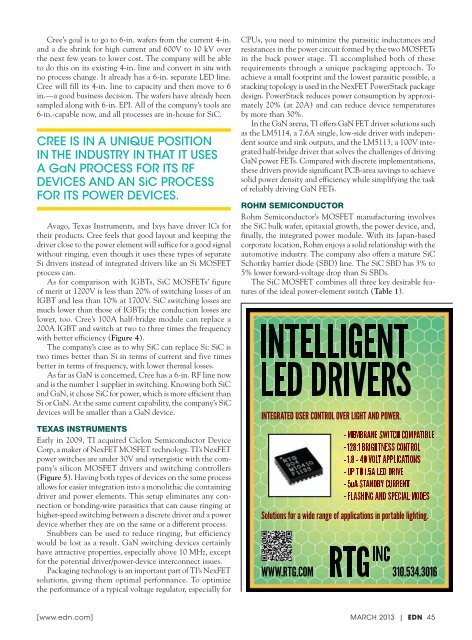201303.pdf 36567KB Mar 22 2013 09:11:22 PM
201303.pdf 36567KB Mar 22 2013 09:11:22 PM
201303.pdf 36567KB Mar 22 2013 09:11:22 PM
You also want an ePaper? Increase the reach of your titles
YUMPU automatically turns print PDFs into web optimized ePapers that Google loves.
Cree’s goal is to go to 6-in. wafers from the current 4-in.<br />
and a die shrink for high current and 600V to 10 kV over<br />
the next few years to lower cost. The company will be able<br />
to do this on its existing 4-in. line and convert in situ with<br />
no process change. It already has a 6-in. separate LED line.<br />
Cree will fill its 4-in. line to capacity and then move to 6<br />
in.—a good business decision. The wafers have already been<br />
sampled along with 6-in. EPI. All of the company’s tools are<br />
6-in.-capable now, and all processes are in-house for SiC.<br />
cree is in a unique position<br />
in the industry in that it uses<br />
a Gan process for its rf<br />
devices and an sic process<br />
for its power devices.<br />
Avago, Texas Instruments, and Ixys have driver ICs for<br />
their products. Cree feels that good layout and keeping the<br />
driver close to the power element will suffice for a good signal<br />
without ringing, even though it uses these types of separate<br />
Si drivers instead of integrated drivers like an Si MOSFET<br />
process can.<br />
As for comparison with IGBTs, SiC MOSFETs’ figure<br />
of merit at 1200V is less than 20% of switching losses of an<br />
IGBT and less than 10% at 1700V. SiC switching losses are<br />
much lower than those of IGBTs; the conduction losses are<br />
lower, too. Cree’s 100A half-bridge module can replace a<br />
200A IGBT and switch at two to three times the frequency<br />
with better efficiency (Figure 4).<br />
The company’s case as to why SiC can replace Si: SiC is<br />
two times better than Si in terms of current and five times<br />
better in terms of frequency, with lower thermal losses.<br />
As far as GaN is concerned, Cree has a 6-in. RF line now<br />
and is the number 1 supplier in switching. Knowing both SiC<br />
and GaN, it chose SiC for power, which is more efficient than<br />
Si or GaN. At the same current capability, the company’s SiC<br />
devices will be smaller than a GaN device.<br />
Texas InsTrumenTs<br />
Early in 20<strong>09</strong>, TI acquired Ciclon Semiconductor Device<br />
Corp, a maker of NexFET MOSFET technology. TI’s NexFET<br />
power switches are under 30V and synergistic with the company’s<br />
silicon MOSFET drivers and switching controllers<br />
(Figure 5). Having both types of devices on the same process<br />
allows for easier integration into a monolithic die containing<br />
driver and power elements. This setup eliminates any connection<br />
or bonding-wire parasitics that can cause ringing at<br />
higher-speed switching between a discrete driver and a power<br />
device whether they are on the same or a different process.<br />
Snubbers can be used to reduce ringing, but efficiency<br />
would be lost as a result. GaN switching devices certainly<br />
have attractive properties, especially above 10 MHz, except<br />
for the potential driver/power-device interconnect issues.<br />
Packaging technology is an important part of TI’s NexFET<br />
solutions, giving them optimal performance. To optimize<br />
the performance of a typical voltage regulator, especially for<br />
CPUs, you need to minimize the parasitic inductances and<br />
resistances in the power circuit formed by the two MOSFETs<br />
in the buck power stage. TI accomplished both of these<br />
requirements through a unique packaging approach. To<br />
achieve a small footprint and the lowest parasitic possible, a<br />
stacking topology is used in the NexFET PowerStack package<br />
design. PowerStack reduces power consumption by approximately<br />
20% (at 20A) and can reduce device temperatures<br />
by more than 30%.<br />
In the GaN arena, TI offers GaN FET driver solutions such<br />
as the LM5<strong>11</strong>4, a 7.6A single, low-side driver with independent<br />
source and sink outputs, and the LM5<strong>11</strong>3, a 100V integrated<br />
half-bridge driver that solves the challenges of driving<br />
GaN power FETs. Compared with discrete implementations,<br />
these drivers provide significant PCB-area savings to achieve<br />
solid power density and efficiency while simplifying the task<br />
of reliably driving GaN FETs.<br />
rohm semIconducTor<br />
Rohm Semiconductor’s MOSFET manufacturing involves<br />
the SiC bulk wafer, epitaxial growth, the power device, and,<br />
finally, the integrated power module. With its Japan-based<br />
corporate location, Rohm enjoys a solid relationship with the<br />
automotive industry. The company also offers a mature SiC<br />
Schottky barrier diode (SBD) line. The SiC SBD has 3% to<br />
5% lower forward-voltage drop than Si SBDs.<br />
The SiC MOSFET combines all three key desirable features<br />
of the ideal power-element switch (Table 1).<br />
INTELLIGENT<br />
LED DRIVERS<br />
INTEGRATED USER CONTROL OVER LIGHT AND POWER.<br />
WWW.RTG.COM<br />
- MEMBRANE SWITCH COMPATIBLE<br />
- 128:1 BRIGHTNESS CONTROL<br />
- 1.8 - 40 VOLT APPLICATIONS<br />
- UP TO 1.5A LED DRIVE<br />
- 5uA STANDBY CURRENT<br />
- FLASHING AND SPECIAL MODES<br />
Solutions for a wide range of applications in portable lighting.<br />
RTG INC 310.534.3016<br />
[ www.edn.com ]<br />
MARCH <strong>2013</strong> | EDN 45






![[270].pdf 37407KB Sep 02 2010 09:55:57 AM - ElectronicsAndBooks](https://img.yumpu.com/50350834/1/185x260/270pdf-37407kb-sep-02-2010-095557-am-electronicsandbooks.jpg?quality=85)
![draaien, A Viruly 1935 OCR c20130324 [320]. - ElectronicsAndBooks](https://img.yumpu.com/49957773/1/190x252/draaien-a-viruly-1935-ocr-c20130324-320-electronicsandbooks.jpg?quality=85)



![20051110 c20051031 [105].pdf 35001KB Feb 18 2009 08:46:32 PM](https://img.yumpu.com/48687202/1/190x253/20051110-c20051031-105pdf-35001kb-feb-18-2009-084632-pm.jpg?quality=85)





